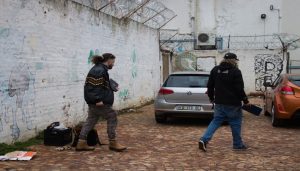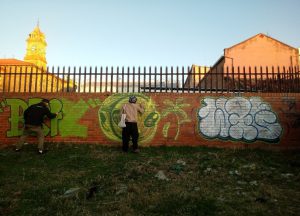By Arno Cornelissen
National Arts Festival (NAF) is the annual gathering of dedicated artists, performers, writers, and creatives from around the country and the world. NAF23 ran from 22 June to 2 July. Makhanda, a small town in the Eastern Cape, is home to the festival where it welcomes the best arts South Africa has to offer for the betterment of humankind and the understanding of the world through different mediums of art and expression.
It is sad how quickly those ten days fly by. The performances die out, the exhibitions get taken down, and the people from all over the country and the globe disappear back to the places from whence they came. The town transitions from an overflowing conglomerate of arts to a quiet student town – with added additions after this year’s festival.
“We travelled across the country from Johannesburg and slept on a friend’s floor. It was a spiritual experience painting the walls of Makhanda,” says Briz, one of the graffiti artists who transformed sections of shared spaces of the town.
“On our first day in town, we walked down an alley where there was a faded mural. A blank canvas. We convinced the shop owners to let us paint the wall. It ended up being an eight-meter production wall with six artists from around the area and the country. Graffiti brings people from different backgrounds together to write a new story”, he added.

Across from the production wall is King’s Barber Shop and Remie’s Hair Salon. Remie Johnson is one of the owners who provided the street artists and graffiti writers the space to work with.
“During the festival, people want to show their talent and contribute to the beauty of the environment,” says Remie. “I don’t know much about graffiti artists, but I think the ones who were here are good people. I trusted them, and they helped us out on a couple of occasions.”
Hojo, one of the street artists who contributed to the wall, explains how “galleries are elitist. You have to be an artist or an upcoming artist and someone who can afford to be a patron. Whereas street art lives alongside people and becomes part of the space they inhabit. It’s wonderful how the town and the people embraced us.”
“Coming to Makhanda allowed us to carve out why our art form is like no other. We make derelict or transitionary spaces more hospitable and appealing to people. The very nature of graffiti and street art is collaboration. I experienced how our craft is informed by learning from each other. It’s a living, breathing thing”, said Hojo.

Wat is originally from Johannesburg and has lived in Makhanda for a few years. He says, “My intention this year was to really push the graffiti and street art in town. I’ve been working with Arno [the author of this article], a journalist, and Mook, a street artist and muralist. Together we have positively promoted graffiti and street art. People mostly react positively to graffiti here.”
“We’re lucky in this town and its dedication to be a hub for creativity and art of the country. Unlike Cape Town, where we would’ve probably been arrested or fined and a lot of our work buffed. I hope to keep expressing myself through graffiti, be a part of this community, and keep positively changing our shared spaces and living environments.”

Even Vuyo Madinda, a municipal electricity department employee who owns an internet café, says, “I like graffiti. We’ve seen the new stuff. I like the names they do with the letters and the different fonts. Spray paint is the best. It’s cool seeing people use it.”
Not only does graffiti stylishly alter the aesthetics of public spaces, but it is also a “tool to educate,” says Buntu Fihla (one of the originators of sparked-up graffiti in the country) during their graffiti book launch at Amazwi South African Museum of Literature. “It’s always been about bettering my community’s discouraging environments. Graffiti makes the environment safer,” says Fihla.



